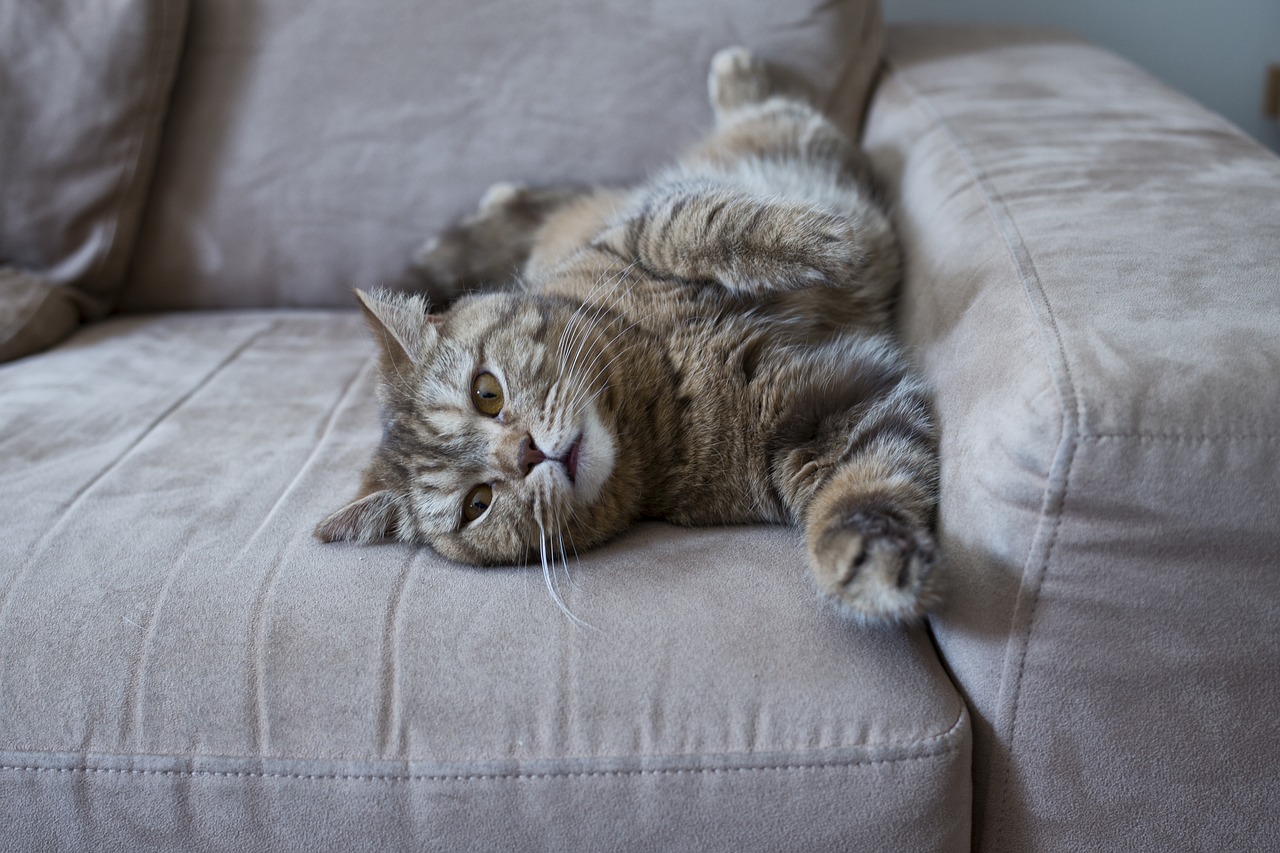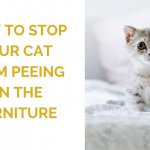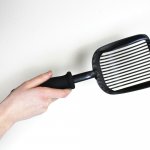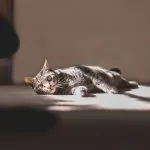How to Stop Your Cat From Peeing Outside the Litter Box
Last Updated on
How to Stop Your Cat From Peeing Outside the Litter Box
Ew. Cat pee.
It’s strong smelling, long lasting, and shouldn’t be an inextricable part of your carpet or cashmere sweater. If your cat has shunned their designated litter box either full or part-time, you might be panicking. No one wants to be known as “cat pee smell girl (or guy)” at work.
I’m sure you’re frustrated, annoyed, and want the cat pee nightmare to end. You’re not alone. Not only is inappropriate urination the most commonly reported cat behavioral issue, it’s also one of the top reasons cats are given to shelters every day. That’s not you, though. Your cat is forever, and you’re prepared to do anything it takes to turn this situation around.
Your first step is to calm down, stop worrying about getting your deposit back, and read this article. It IS possible to make your cat stop urinating everywhere and it IS possible to get rid of that cat pee smell.
First of all, figure out WHY your cat isn’t peeing in the litter box.
Cats instinctively cover up their waste. If they’re going outside of the litter box, it means something is wrong. To get your cat back in the litter box and the stench out of your house, you’ll first need to identify the source of the problem.
Is your cat doing this because they’re sick?
Before trying to stop your cat’s “annoying habit” of peeing all over the house, eliminate any possibility of an underlying health issue. Cats by nature are extremely sanitary creatures, and urinating outside of a designated toilet space can be a sign of a bigger problem. Instead of assuming your cat has gone crazy and is trying to rebel against you- your first step should be to get a clean bill of health.
Inappropriate urination can be a warning sign of a number of feline diseases and disorders, including:
- FLUTD
- Kidney disease
- Hyperthyroidism
- Arthritis
Always rule out health issues first. Leave the following steps for after your cat has a clean bill of health, or if there is a health-related reason for your cat’s inappropriate urination, until after they’ve started treatment.
One of the most common reasons for inappropriate urination is Feline Lower Urinary Tract Disease (FLUTD). For more information on preventing this life-threatening disease, see our article, Cat UTI Home Remedies – You Can Help Your Cat!
Are they letting you know that they’re stressed out?
There’s a trigger behind every cat’s behavioral issues. More often than not, that trigger is the hard to define and mysterious S-word. I’m going to spell it out for you. S-T-R-E-S-S. We’d love to think that our cats experience life in a continual state of carefree bliss, simply satisfied by sunbeams and adventures in the underbrush… but they don’t. Cats can get stressed out and worried just like people do, and different cats express their stress in different ways. If your cat’s inappropriate urination is caused by stress, it’s likely that they’ll be showing other symptoms. Note that all of these symptoms can also indicate a health issue.
Signs your cat is stressed out:
- Excessive grooming
- Constant meowing
- Self-isolation
- Increased sleeping
- Decrease in appetite
- Aggression
Stress may be the label for an intangible set of issues, but that doesn’t mean it’s any less real or affecting for our cats. Chronically stressed cats have even been known to have decreased immune responses, leaving them susceptible to all sorts of problems
If you think your cat might be stressed out, your first step is to pinpoint the stressor, and eliminate it if possible. Sometimes it’s obvious. The new puppy who chases your cat up the wall. The heavy-booted construction crew which has been remodeling the kitchen for the past three months. The screaming new human addition to the family. The ghost who lives in the bedroom closet. These stressors are hard to simply get rid of. In the case that you can’t eliminate the stress trigger, you have options. A popular solution is Feliway, a synthetic feline facial pheromone solution which can be sprayed or diffused in your home. It’s known to help cats feel more comfortable and relaxed. Many cats also experience reduced stress-levels when they are given vertical space to roam. Cats feel safer when they can observe the world below them and see what’s going on. Plus the puppy can’t climb that well. If you aren’t in the position to catify your home with wall shelves, try purchasing a tall cat tree.
Cat stress solutions:
- Vertical space – that means wall shelves, cat trees, cat condos, and cat-friendly bookshelves
- Feliway cat pheromone spray
- Catnip
Could this have anything to do with hormones?
Reproductively intact cats – both males and females – are more inclined to mark their territory by “spraying”. Classically, this involves standing with their rear to a surface and, with tail quivering, letting out a jet of urine.
This territorial marking behavior is exacerbated by stress, particularly stress involving a new cat in the home. In females, it tends to happen most when they’re in heat.
If your cat hasn’t been spayed or neutered and has an issue with inappropriate urination, consider scheduling an appointment to get the snip. Life is a lot easier when it’s not driven by hormones. Remember that old habits die hard. If they are spayed or neutered later in life, your cat may continue with this type of behavior post-operation.
Or are they just a clean freak?
Most cats are semi-obsessed with cleanliness. Why do you think they groom themselves all day long? It’s up to us to keep up with our cats’ need for clean and scoop the litter box as often as they want – even if that means after every use. While most cats seem to be satisfied with a once or twice daily scooping (depending on how many cats and boxes you have available), particularly picky cats may require additional scooping or boxes. As a rule of thumb, provide your cat(s) with one more litter box than the number of cats in the home. If you have a multi-story home, ensure that each floor has at least one litter box.

Unfortunately, these automatic litter boxes are expensive (up to $500), usually break down within a few years if they’re an electronic one, and some cats refuse to get used to them. Consider carefully before making the investment!
Petapproves.com recommends the Littermaid LM980 Mega Self-Cleaning Litter Box as the best self-cleaning box on the market. Click here to read their full buyer’s guide.
Location is also important to many cats. Most cats don’t like eating in the same vicinity as their toilet, to try to keep their feeding station in a separate space. If you have more than one cat, space out the litter boxes so that each cat can have privacy. The boxes should be placed in a quiet, low-traffic location where your cat feels safe.
Is the litter box the real problem?
Sure, some cats accept any litter. Maybe they’re used to going outside, where they have little say over whether sand, clay, gravel, or snow is the available waste-covering substance. Other cats, however, can be more selective. The majority of cats prefer an unscented clay litter with a fine, granular texture similar to that of a coarse sand.
If you’re not sure what kind of litter your cat might like, don’t worry. You have a lot of options. Litter is constantly evolving, and you’re sure to find something your cat likes. Try filling a couple of litter boxes with different types of litter and observe what your cat chooses. Once you find one which your cat likes, stick with it.
Be aware that declawed cats frequently have litter box issues due to painful and sensitive paws. If the litter hurts their paws, the cat may avoid the box and go somewhere more comfortable instead. Yesterday’s News litter, a soft paper litter, is often recommended for cats who are still recovering from the operation. Some cats never fully recover from declawing and experience lingering pain, so you if you have a declawed cat who refuses to use the litter box, experiment with a softer litter.
Try pouring different amounts of litter into the litter box. If there isn’t enough litter in the box, it will quickly reach its absorption limit, and the rest of the urine will pool in the bottom. Believe me, your cat doesn’t want to stand it their own urine. 1 ½ – 3 inches of litter is usually recommended.
Don’t forget to consider the litter box, too. If your cat is using a hooded litter box, consider an open one, and vice versa. According to a 2013 study put on by Ross University School of Veterinary Medicine, cats generally do not prefer one type of box over the other. That doesn’t mean it’s not worth a try with your cat.
Now it’s time to get rid of that smell for good.
It’s no secret that cats like to revisit the scenes of their crimes. If you leave any urine residue uncleaned, it’s almost guaranteed that your cat will return and re-soil the area. This can lead to a vicious and disheartening cycle of cursing and cleaning, especially in multi-cat homes. An accident caused by a closed laundry room door can be the beginning of a nightmare when your cats decide that since the sofa cushion smells like a litter box, it must be one.
It’s best to get to the urine stain before your cat strikes again, but late is better than never. A complete cleaning and removal is key to ending inappropriate urination.
Here’s how to do it.
5 Steps to Eliminating Urine Odor 
- Invest in a blacklight. The chemicals in cat urine glow under UV light, making it easy to detect all of the urine stained areas in your house. Not only is it a lot easier to find all of the urine in your house, it’s more graceful and less disgusting than scooting around with your face one inch from the carpet sniffing out cat pee. You can mark the urine stained area using string or a water-soluble chalk. Before you use any chalk on your carpet or sofa cushions, try it in an inconspicuous area first and be sure you are able to remove it.
- If you’re working with a fresh mess, blot up any moisture with a damp towel before applying your cleaner.
- Use a high-quality ENZYMATIC cleaner. While many people recommend vinegar or hydrogen peroxide solutions for cat urine, these cleaners only temporarily get rid of odors. The same is true for cheap grocery store urine removers. The urine is still there, and your cat can tell. Don’t be surprised when you find your cat squatting over the area you just cleaned. Enzymatic cleaners work differently. They literally consume the chemical compounds in cat urine- meaning you can spray them on and walk away.
- Apply the cleaner in a slightly larger area than the urine stain which you’re able to see with the blacklight. Oftentimes the urine has soaked in, and what we see is just the tip of the iceberg.
- Re-apply the cleaner until all traces of odor are gone. You can confirm that the urine has been removed with the blacklight.
What worked for you?
Have you ever re-trained a cat who habitually urinated outside of the litter box? Please let us know what worked for you in the comments! If you are still struggling to resolve your cat’s inappropriate urination after trying these tips, drop us a line and we’ll do our best to help you and your cat out.









